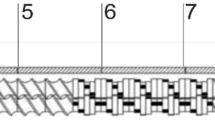Abstract
Impact modified blends of polypropylene (PP) and a commercial polyolefinic elastomer (POE) were prepared and further reinforced with suitable nanoclay. The addition of elastomer and nanoclay improved the impact properties significantly, whereas moderate improvement was observed in tensile strength, flexural strength, flexural modulus, and elongation at break. The heat distortion temperatures of the filled compositions were close to that of neat PP. The compositions exhibited excellent flow characteristics. Blending sequence between PP, POE and Nanoclay was altered and its effect on the properties of Nanocomposite was investigated. The preferential migration of the blend components leading to different intercalated morphology was reported.

Similar content being viewed by others
References
De SK, Bhowmick AK (1990) Thermoplastic Elastomers from Rubber–Plastic Blends, 1st ed., Ellis Horwood series in Poly. Sc. & Tech., 102
Paul S, Kale DD (2000) Impact modification of polypropylene copolymer with a polyolefinic elastomer. J Appl Polym Sci 76:1480–1484
Long Y, Shanks RA (1996) PP/Elastomer/Filler hybrids: 1. Processing, microstructure and mechanical properties. J Appl Polym Sci 61:1877–1885
Kim BK, Do IH (1996) Effect of viscosity ratio, rubber composition, and peroxide/coagent treatment in PP/EPR blends. J Appl Polym Sci 61:439–447
Danesi S, Porter RS (1978) Blends of isotactic polypropylene and ethylene-propylene rubbers: rheology, morphology and mechanics. Polymer 19:448–457
Lemstra PJ, Meijer HEH, Van Gisbergen JGM (1989) Structured polymer blends: 2. Processing of polypropylene/EDPM blends: controlled rheology and morphology fixation via electron beam irradiation. Polymer 30:2153–2157
Dao KC (1984) Rubber phase dispersion in polypropylene. Polymer 25:1527–1533
Inoune T, Suzuki T (1995) Selective crosslinking reaction in polymer blends. III. The effects of the crosslinking of dispersed EPDM particles on the impact behavior of PP/EPDM blends. J Appl Polym Sci 56:1113–1125
Speri WM, Patrick GR (1975) Fiber reinforced rubber modified polypropylene. Poly Eng Sci 15:668–672
Han CD, Kim YW (1977) Morphology and mechanical properties of injection-molded specimens of two-phase polymer blends. J Appl Polym Sci 21:353–370
Paul S, Kale DD (2002) Rheological study of polypropylene copolymer/polyolefinic elastomer blends. J Appl Polym Sci 84:665–671
Acknowledgements
One of the authors (SH) would like to express his warmest gratitude to UGC for providing him Junior Research Fellowship during the above investigation.
Author information
Authors and Affiliations
Corresponding author
Additional information
This work has been done in 2005 as part of the completion of academic degrees of SH and DL
Rights and permissions
About this article
Cite this article
Hazra, S., Paul, S. & Langhe, D.S. Preferential migration of blend components leading to different intercalated morphology. Int J Plast Technol 14 (Suppl 1), 30–36 (2010). https://doi.org/10.1007/s12588-010-0007-1
Received:
Accepted:
Published:
Issue Date:
DOI: https://doi.org/10.1007/s12588-010-0007-1




